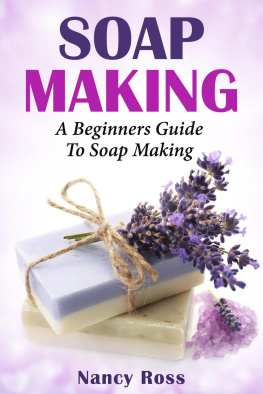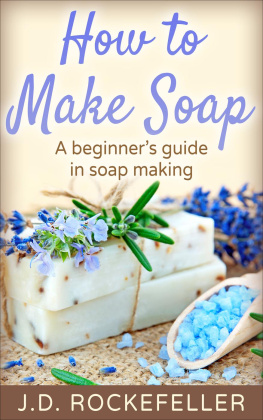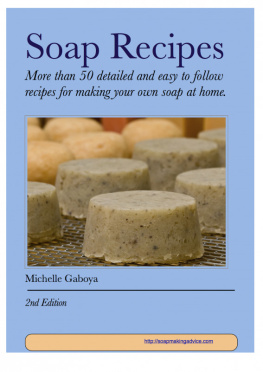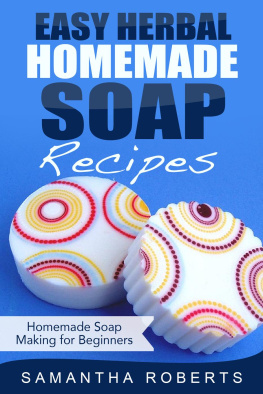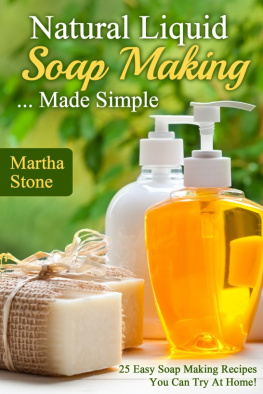Ariel Horowitz - Soap Making Made Easy
Here you can read online Ariel Horowitz - Soap Making Made Easy full text of the book (entire story) in english for free. Download pdf and epub, get meaning, cover and reviews about this ebook. year: 2013, publisher: Speedy Publishing Books, genre: Home and family. Description of the work, (preface) as well as reviews are available. Best literature library LitArk.com created for fans of good reading and offers a wide selection of genres:
Romance novel
Science fiction
Adventure
Detective
Science
History
Home and family
Prose
Art
Politics
Computer
Non-fiction
Religion
Business
Children
Humor
Choose a favorite category and find really read worthwhile books. Enjoy immersion in the world of imagination, feel the emotions of the characters or learn something new for yourself, make an fascinating discovery.

- Book:Soap Making Made Easy
- Author:
- Publisher:Speedy Publishing Books
- Genre:
- Year:2013
- Rating:5 / 5
- Favourites:Add to favourites
- Your mark:
- 100
- 1
- 2
- 3
- 4
- 5
Soap Making Made Easy: summary, description and annotation
We offer to read an annotation, description, summary or preface (depends on what the author of the book "Soap Making Made Easy" wrote himself). If you haven't found the necessary information about the book — write in the comments, we will try to find it.
Soap Making Made Easy — read online for free the complete book (whole text) full work
Below is the text of the book, divided by pages. System saving the place of the last page read, allows you to conveniently read the book "Soap Making Made Easy" online for free, without having to search again every time where you left off. Put a bookmark, and you can go to the page where you finished reading at any time.
Font size:
Interval:
Bookmark:
Soap Making MadeEasy
ABeginners Guide To Making Great Soap
By:Ariel Horowitz
Disclaimer
This publication is intended toprovide helpful and informative material. It is not intended to diagnose,treat, cure, or prevent any health problem or condition, nor is intended toreplace the advice of a physician. No action should be taken solely on thecontents of this book. Always consult your physician or qualified health-careprofessional on any matters regarding your health and before adopting anysuggestions in this book or drawing inferences from it.
The author and publisherspecifically disclaim all responsibility for any liability, loss or risk,personal or otherwise, which is incurred as a consequence, directly orindirectly, from the use or application of any contents of this book.
Any and all product namesreferenced within this book are the trademarks of their respective owners. Noneof these owners have sponsored, authorized, endorsed, or approved this book.
Always read all informationprovided by the manufacturers product labels before using their products. Theauthor and publisher are not responsible for claims made by manufacturers.
2013
Manufactured in the United Statesof America
This book is dedicated to allself sufficient individuals.
Peoplehave made soap for hundreds of years for helping to remove dirt and oil fromskin, dishes, surfaces or clothing. In the past, individuals had to make soapat home because it was not available in stores. Making soap at home was atime-consuming, dirty and hot process that many pioneers only did once a year.
Thetypical ingredients included animal fat that required hunting for animals,butchering and rendering the fat. In various geographic regions, vegetable oilwas preferred instead for making hard soap. However, collecting vegetable oilwas also a laborious chore that required harvesting fruits or vegetables toprocess to collect the essential oils.

AlkalineSolutions
Atthe same time, ancient people had to gather additional ingredients such asalkaline substances that assist with breaking down skin oils. Alkalinesolutions used to make soap are called lye that actually is sodium hydroxide.The combination of lye and fats creates a chemical reaction that hydrolyzes thefats to make a solid soap. Making soap with these methods during ancient timesrequired individuals to use open fires while carefully watching the mixturebefore placing it in molds to harden. Because making soap was a long anddifficult process, many people learned to barter or sell soap for other goods.
AddingScents
Eventually,inventive individuals learned how to make special soaps with fragrances,emollients and other ingredients. People enjoyed using scented soaps thatmoisturized the skin or added fragrance to fabrics. A popular ancient soap hadthe ingredient cassia made from the buds of a tree. This light cinnamon scentwas helpful for deodorizing the skin during a time before there were deodorantproducts. The soap was also helpful for cleaning wool from sheep and goatsbefore the fibers were used to weave fabrics. When cassia was not available,people used alternate ingredients such as sesame seed or cypress oil. Woodashes left over from hot fires were also an alternative ingredient for makingsoap. Delicately scented soaps were also devised using fragrant oils fromlavender or rose flower petals.
SpecializedSoaps
InChina and other countries, soaps were made from local wild spices and plants.Many groups kept the art of soap making a secret to avoid sharing recipes withothers. This made certain varieties of soaps valuable for trading purposes.Factories in Europe began to make specialized or fine soaps during the 1600sthat were desired by royal or wealthy individuals. In Italy, hard soaps madewith olive oil were popular to soothe and moisturize dry skin. In Spain,delicate and white Castile soap was created using oils from the locally grownlaurel and olive plants.
HowSoap Products Became Popular
Entrepreneursopened factories in several geographic regions to manufacture specialized soapssuch as Pears Soap, a translucent variety with a unique and delicate scent.Ivory Soap is popular because it is a gentle soap that floats on the surface ofwater.
Becausepeople also wanted laundry soap, manufacturers began to grind soap with amortar and pestle to make flakes that dissolved quickly in warm water. By thelate 1800s, soap making became a big business with large factories opening inmajor cities. Many of these factories still exist today, making numerousvarieties of soap and laundry products. Intensive advertising of soap productsin newspapers and magazines quickly made individuals want to buy soaps in localstores.
TheInvention of Liquid Soaps
Duringthe late 1800s, liquid soaps were also invented for washing dishes or fabrics.Companies also developed stronger liquid soaps for household cleaning purposessuch as washing floors, bathroom fixtures or kitchen countertops. Liquid soapswere popular with homemakers because it quickly mixed with water whilesanitizing household items. This allowed individuals to complete chores such aswashing clothing much faster. Liquid soaps also left less sticky residue onclothing and surfaces while ensuring items were cleaned thoroughly. Today, thereare hundreds of liquid soap products available in a variety of scents forspecialized cleaning purposes.
HowSoaps Get to Stores
Mostmodern soaps are made in large factories in big batches with either hot or coldchemical processes. Hot processes for soap making vary in temperature such asboiling, warm or normal formats; cold processing of soaps is the most popularmethod using old-fashioned mixing of lye and water to create hard soaps.
Aftersoap is prepared, it is placed in molds of different shapes and sizes to dry.The average drying time for hard soaps is three days. When soaps are completelydried and hardened, the products are packaged in paper, plastic or cardboardpackages. Large boxes of packaged soaps are delivered to warehouses and storesby trucks or trains. Today, individuals shopping for soap expect to find an aislefilled with product choices.
Developmentof Modern Soaps
Eachmanufacturer of soap uses specialized formulas with particular ingredients.This specialization makes a unique product that is desirable by differentcustomers. Companies have devised formulas using pumice grains that make astrong soap that removes heavy dirt such as grease. Alternatively, there aredelicate soaps created for the sensitive skin of babies. There are soapformulas that are designed to deodorize or medicate the skin. Medicated soapsmight help prevent acne or relieve itchy dermatitis. Recently, antibacterialsoaps have become popular to prevent the spread of infections. Both hard andliquid antibacterial soaps are commonly used in bathrooms and kitchens todestroy bacteria.
Ifyou are confused about the whole soap making process, you're about to find outabout it. You probably hear people talking about cold process, hot process,melt and pour, rebatching, and possibly mentioning soap-making kit. To serioussoap-makers, soap making refers to the actual production of new soap. That is,you start with soap making ingredients, lye and oils, mix them together, andproduce soap that did not exist before.
WhyMake Your Own Soap
Thereare people that just aren't interested in making soap from scratch. For them,they enjoy decorating soap rather than cooking up soap. They like to focus onthe appearance, colors, scents, and swirls, rather than that first stage ofcombining ingredients to create a basic soap. When these individuals talk aboutmaking soap, they are often talking about "melt and pour" and"rebatching". With these methods, soap is not made from scratch. Youtake soap that has already been made and melt it down. You then smooth it outand start decorating it.
Font size:
Interval:
Bookmark:
Similar books «Soap Making Made Easy»
Look at similar books to Soap Making Made Easy. We have selected literature similar in name and meaning in the hope of providing readers with more options to find new, interesting, not yet read works.
Discussion, reviews of the book Soap Making Made Easy and just readers' own opinions. Leave your comments, write what you think about the work, its meaning or the main characters. Specify what exactly you liked and what you didn't like, and why you think so.

